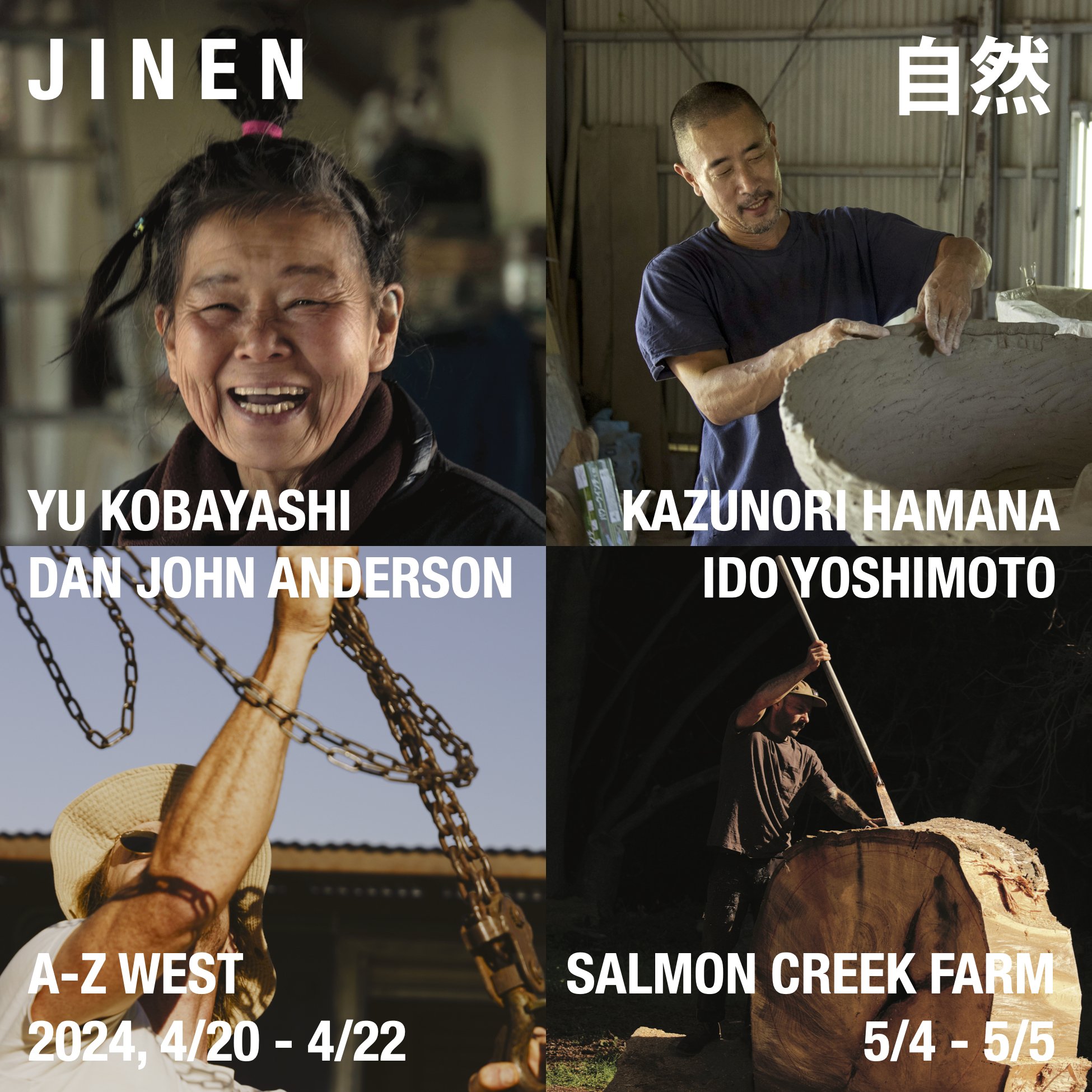JINEN, is a traveling exhibition co-curated by Dan John Anderson and Tabito Masumura with new work from Dan John Anderson, Kazunori Hamana, Yu Kobayashi, and Ido Yoshimoto.
Public viewing hours:
Saturday, April 20th, 11-8pm
Sunday, April 21st, 12-4pm
Monday, April 22nd, 12-4pm
The artists, two living and working in California, and two practicing in Japan, are drawn together here to explore the shared interests of their varying practices which are each inspired at a fundamental level by their own experiences of living with nature.
In origin this project emerged organically between the four artists through shared inspirations that blossomed both in a moment and over time. The end product is a proposal in which the artists exhibit works in two very different yet iconic Californian landscapes: A-Z West in the Mojave Desert and Salmon Creek Farm in the coastal redwood forests.
For the first iteration of this project the artists will install their works in and around the “A-Z Planar Pavilions” at A-Z West, an artwork and 80 acre compound by artist Andrea Zittel in the Mojave town of Joshua Tree. For the second iteration, the artists will install their works among the shaded depths of the Redwoods at Salmon Creek Farm, a former counterculture commune and now a queered commune-farm-homestead and land-based non profit by Fritz Haeg on the Mendocino coast.
Presented by Curator’s Cube Japan, JINEN will take place at A-Z West in Joshua Tree, CA from April 20–22, 2024 and then travel to Salmon Creek Farm in Albion, CA from May 3–5, 2024.
About the Artists:
Dan John Anderson (b. 1977) was born and raised in rural Eastern Washington. Growing up immersed in the wilderness of the Pacific Northwest, he developed an inspired connection with nature and found wood as a kind of gateway medium of expression that continues to be an anchor to his practice. Dan and his studio are now based in the Mojave Desert outside of Joshua Tree, California. His continued commitment to a feeling of connection with his natural surroundings, exploring the expressive potential of materials, engaging with their inherent character and historical significance have become a way of collaborating with the material and unlocking for him unconscious truths that point to a more transcendent way of creating and being.
Kazunori Hamana (b. 1969, Hyogo, Japan) has resided and worked in Chiba Prefecture since 2008. His educational background in agriculture during high school, followed by studying the environment in the US, greatly influenced and shaped his life. The majority of his creative work is done by making use of materials available in his living environment. The element of climate - harmony and circulation - is a major factor in his life and creations. While Hamana is recognized in the contemporary art scene for his ceramic expressions, he sees ceramic work as a broader form of creation. For him, creating food for daily sustenance such as rice cultivation and fishing, and revitalizing old houses in the area to preserve the local environment, hold equal significance as forms of artistic expression. All these expressions are vividly transformed from the stimuli of his surroundings and daily life, and his philosophy draws from primal and timeless principles.
Yu Kobayashi (b. 1965, Aichi, Japan) is based in Shizuoka after studying pottery in school. Her first studio was an old farmhouse on top of a hill in a tea plantation, a speciality of the region, which she renovated with materials collected in the area. Later, in 2003, she built her current studio close to the sea, also using many materials collected in the area, where she lives and works. In front of her studio is a small field where she grows the vegetables and herbs she needs for her life, and next to it she sculpts and makes furniture from blocks of wood from the beach, and when it rains she paints inside the house and twists the clay to make pottery. She also carefully manages her body, running on the beach, swimming in the sea and stretching to get the body she needs to live. The bookshelves in her home are lined with handmade books documenting all her training, cooking and travels. Every challenge she takes on in life is a creation for herself, and all the energy she gets out of it becomes her work of art. By circulating energy in a very simple way, she is able to breathe and at the same time continue to create beautiful and balanced works of art.
Ido Yoshimoto’s (b. 1978) work is deeply rooted in the land and the forest where he grew up and currently lives. After over 40 years in West Marin and 20 years working as an arborist, his appreciation for the trees and thorough understanding of them has naturally led to his current practice. It is with reverence for the story of and within these trees that care is taken in selecting material and slowly peeling back the layers. Working with large chunks of raw material, Yoshimoto explores form, creating both functional and sculptural pieces. Each is also a conversation. The tree tells the story of its life through the grain, the annual rings, the scars. Then there is the response and the questions, the influence and inspiration that sees possibility in the story. Hopefully the outcome is a sum greater than the two. A record of a meeting in which each was heightened by the other.
